
All our bats use trees for roosting and foraging. Along with spiders, they are the major predators of night-flying insects, providing an economic benefit to forests and agriculture.
The Pennsylvania Game Commission (PGC) is responsible for the conservation of our bats in partnership with the U.S. Fish and Wildlife Service (USFWS) where federally listed species occur.
We have six species of bats that use underground structures (caves, abandoned mines, and tunnels) for hibernation in winter, three species that mostly migrate south for the winter, and two southern species rarely detected in summer (https://www.pgc.pa.gov/Education/WildlifeNotesIndex/Pages/Bats.aspx).
The greatest challenge today is the white-nose syndrome (WNS). WNS was confirmed in PA in the winter of 2008-09. Before WNS cave bats represented our major bat populations. The common little brown bat was the first indicator of the damage. For managers, the priority is identifying and protecting surviving populations that may have natural resistance and/or behavior that inhibits WNS impacts. It will be a long road to recovery as most impacted species have only one pup per year.
Hibernacula Conservation —
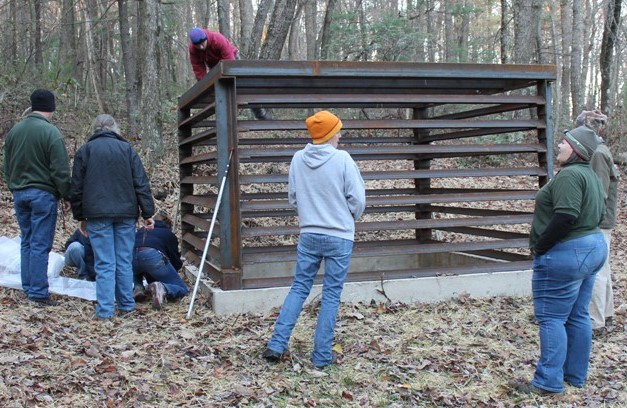
Bat gate above vertical entrance. Bats enter and spiral down the entrance.
The most vulnerable habitat for our cave bats is their hibernaculum where they congregate to overwinter (~6 months) on finite fat reserves. With the arrival of WNS, it is critical to identify sites with survivors and limit human disturbance. Unscheduled arousals deplete fat reserves. Gating is a last resort and satisfies three functions: allowing bats to fly through, preserving the natural airflow, and keeping people out. Working with professionals familiar with bat gate details is mandatory. For example, exploring bats may enter hollow steel columns and get trapped. The downfall of gating is that it slows bat fly-through making them prone to predation by free-roaming house cats and raccoons.
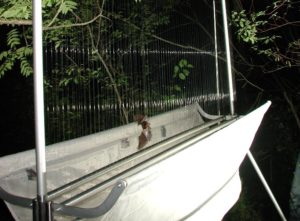
Researchers use harp traps and nets to capture flying bats at hibernacula and travel corridors.
In fall cave bats swarm around and through a hibernaculum for mating. Fall swarming is not completely understood but likely some communication occurs to familiarize others with sites.
A successful hibernaculum is also dependent on the surrounding habitat. As bats congregate in fall and then emerge in spring, fat reserves need to be replenished. A diverse forest ecosystem provides foraging, roosting, and water resources. Forest vegetation around a hibernaculum supports airflow, temperature, and humidity within. Entrances should be kept clear of nearby thorny/sticky vegetation such as common burdock and hawthorn. Common burdock and bat fur interact like Velcro. Most successful hibernacula are situated in a sink or hollow that collects cold air creating cool to cold stable temperatures within. Modifying the entrance and immediate surrounding terrain can impact a hibernaculum. If done correctly modifications can enhance a poor hibernaculum.
Summer Habitat Conservation —
Generally, as mid-April approaches cave bats begin emerging from their hibernaculum and migrate to summer habitats. The diversity of forest structure and water resources is as important as that which surrounds the hibernaculum. Maternity roosts are vital as females will be pregnant and need food resources for nursing pups. Most have only one pup per year. Roosts are primarily trees with exfoliating bark, tree cavities, tree foliage, rock crevices, and often buildings. Maternity roost solar exposure is important. Females select warm sites needed for embryo and pup development. Migrant species return later in April-May roosting in tree foliage, cavities, and exfoliating bark. There is evidence of some overwintering in PA and most birth multiple pups.
The development of artificial roosts or bat houses is a successful tool for habitats lacking forest maternity roost structures and alternative roosts for bats evicted from buildings. PGC bat house plans and instructions are available online.
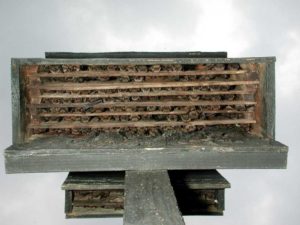
Bat house with a maternity colony of little brown bats.
Alternative roosts have been successful for little brown, big brown, and Indiana bat management, providing a tool for monitoring populations. Where travel between maternity roosts and foraging habitat is fragmented, predisposing them to predation, roadkill, etc., installing bat houses in foraging habitats is an option. If you are aware of existing summer roosts, consider getting involved in the PGC’s Appalachian Bat Count.
Other impacts on our bat population include migration mortality at wind farms, traveling habitat removal, and highway crossings. Wind farm mortality of both bats and birds has become a concern. PGC worked with the industry to create the Wind Energy Voluntary Cooperative Agreement (WEVCA) to research and minimize wildlife impacts through siting and operation. Developers of current or future wind farm sites are encouraged to join WEVCA.
Pennsylvania Natural Heritage Program (PNHP) —
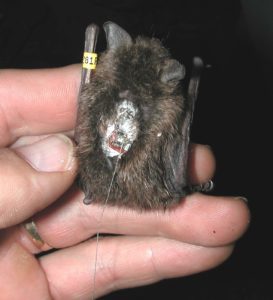
Indiana bat with band and temporary glued transmitter for migration and habitat research.
PNHP is a partnership of state and federal organizations that gather and provide information on the location and status of critical ecological resources including bats. Industry and developers can use PNHP’s tool to recognize possible project impacts. Permits often require the tool and coordination with the responsible state/federal agency to avoid, minimize or mitigate impacts often producing a win-win conservation project.
Habitat Conservation Plan (HCP) —
To streamline project environmental reviews for federally listed species, non-federal entities can complete an HCP with the USFWS. The PGC and the Department of Conservation and Natural Resources teamed to create a joint HCP for bat conservation on our public lands.
In summary, we Pennsylvanians are recognized leaders in bat conservation via the sharing of resources and ideas locally through the PA Mammal Technical Committee and regionally with the Northeast Bat Working Group; all are working together to undertake conservation challenges![]()
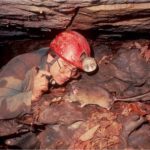
Cal Butchkoski is a retired Supervisor for the Bureau of Wildlife Management, Wildlife Diversity Division, Mammal Section at the Pennsylvania Game Commission.




